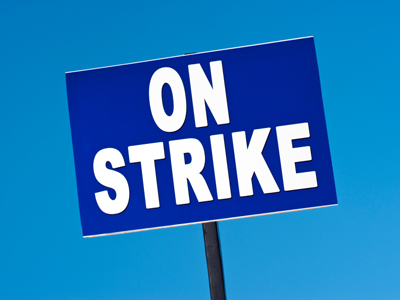
Ask the AI Tutor
Need help with Britain: British Society 1951-1979 - Employment And Labour Relations? Ask our AI Tutor!
AI Tutor - Lucy
Connecting with Tutor...
Please wait while we establish connection

Unions traditionally tried to enforce strikes by picketing.
Britain: British Society 1951-1979 - Employment And Labour Relations
This GCSE History quiz looks at jobs, trade unions and industrial disputes in Britain between 1951 and 1979, and asks how governments tried to manage employment relations.
1 .
During the long period of Tory government, 1951 to 1964, the Conservatives tried to establish an industrial partnership with the unions, assisted by rising living standards. Harold MacMillan, prime minister from 1956 to 1963, even asserted at the 1959 general election: "You've never had it so good". What word was used to describe this wealth?
Affluence
Wellbeing
Contentment
Materialism
This prosperity was not to last. When governments began to urge wage restraint, unions were likely to be wary
2 .
Shortly after his re-election in 1966 Wilson faced a six week strike by one group of workers, whom he had described as "a tight-knit group of politically motivated men". To which union was he referring?
The National Union of Mineworkers
The Transport and General Workers Union
The National Union of Public Employees
The National Union of Seamen
As a Labour leader Wilson was generally sympathetic to the unions, but occasionally one union or another would annoy him
3 .
In late 1978 the Callaghan government was faced by serious strikes, called mainly by public sector unions. Some of these spilled over into 1979. What name was given to the whole period?
The time of strife
The winter of discontent
The time of troubles
The winter of rage
A Labour government was faced with a major challenge from its ostensible friends and allies
4 .
In December 1973 Heath shut down industry for a period of the week to save fuel. How long was the new (temporary) working week?
4 days
2 days
3 days
1 day
The fuel shortage was made worse by the Arab oil embargo, announced in late 1973 following the 1973 Arab-Israeli War
5 .
In February 1974 Wilson returned to power and moved swiftly to solve the dispute with the miners. Who was the new Minister of Employment?
Michael Foot
Roy Hattersley
Jim Callaghan
Roy Jenkins
An immediate solution to the current miners' strike was swiftly found
6 .
Heath's Tory government from 1970 to 1974 introduced a bill in 1971 to curb trade unions' activities. What was this measure called?
The Trade Union Reform Act
The Industrial Relations Act
The Trade Union Act
The Trade Union Powers Act
This measure seemed to many to bear an uncanny resemblance to the proposals that the Wilson cabinet contemplated bringing In three or four years before
7 .
In 1972 and again in 1974 the miners' union struck for more pay. Who was the union's president at this time?
Sam Cook
Arthur Scargill
Joe Gormley
Peter Heathfield
A miners' strike was a serious matter, for coal was still much relied upon for fuel and power
8 .
Unions traditionally tried to enforce strike action by picketing - i.e. by stationing a number of their members at the entrance to strike-bound premises, who would peacefully attempt to persuade union members attending for work not to cross. Tactics of mass picketing were dramatically used in the 1970s at a premises in North London, where NUM pickets were deployed in large numbers in a dispute where they had no direct involvement. What was this dispute called?
Saltley
Dagenham
Grunwick
Longbridge
Mass picketing was a recognised problem in the 1970's, but no legislative solution to the practice evolved until much later
9 .
Unions had especially important influence in framing the Labour Party's policy. Union leaders could deploy the votes (in elections to decide Labour policy) of all of their members who paid the political levy, as they wished. What is this system called?
The Block Vote
The union lobby
Plural voting
The list system
This practice could lead to wide swings of opinion, as some unions could cast a million votes or more - one way or another. A key example of this is the 2 votes taken on the question of unilateral nuclear disarmament: one in favour in 1960, and one against in 1961
10 .
During Harold Wilson's first premiership (1964-70) the Minister of Labour, Barbara Castle, issued a white paper that proposed curbing the right to strike in an attempt to deal with "wildcat strikes" (i.e. those led suddenly by local union figures). What was Castle's white paper called?
Forward Together
In Place of Strife
Partnership in Industry
The Labour Code
Castle failed to secure the support of the TUC leadership for her plan, but the ensuing Tory government issued very similar proposals in 1971
**Unlimited Quizzes Await You! 🚀**
Hey there, quiz champ! 🌟 You've already tackled today's free questions.
Ready for more?
Ready for more?
🔓 Unlock UNLIMITED Quizzes and challenge yourself every day. But that's
not all...
not all...
🔥 As a Subscriber you can join our thrilling "Daily Streak" against other
quizzers. Try to win a coveted spot on our Hall of Fame Page.
quizzers. Try to win a coveted spot on our Hall of Fame Page.
Don't miss out! Join us now and keep the fun rolling. 🎉
**Unlimited Quizzes Await You! 🚀**
Hey there, quiz champ! 🌟 You've already tackled today's free questions. Ready for more?
🔓 Unlock UNLIMITED Quizzes and challenge yourself every day. But that's not all...
🔥 As a Subscriber you can join our thrilling "Daily Streak" against other quizzers. Try to win a coveted spot on our Hall of Fame Page.
Don't miss out! Join us now and keep the fun rolling. 🎉






